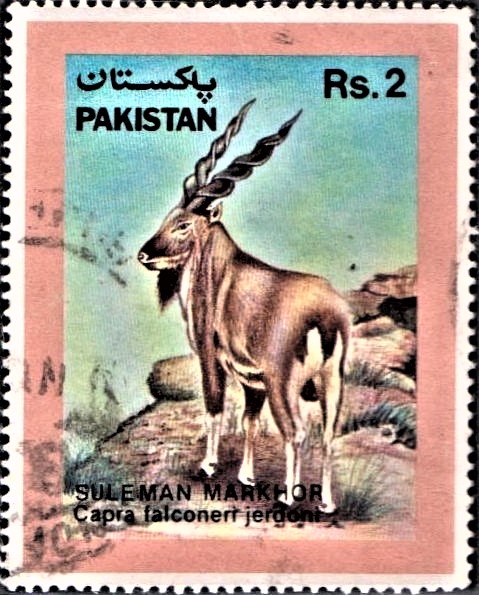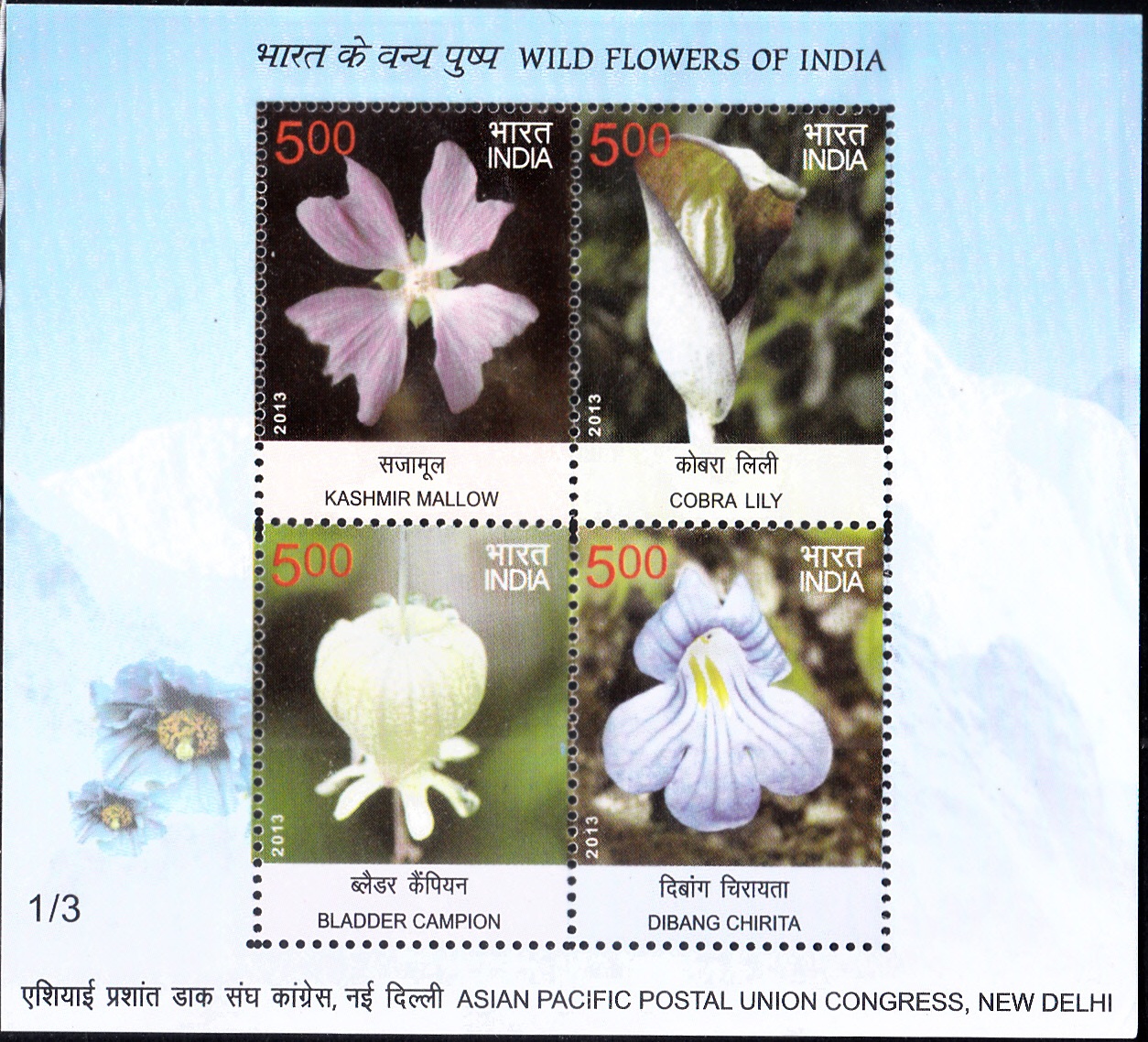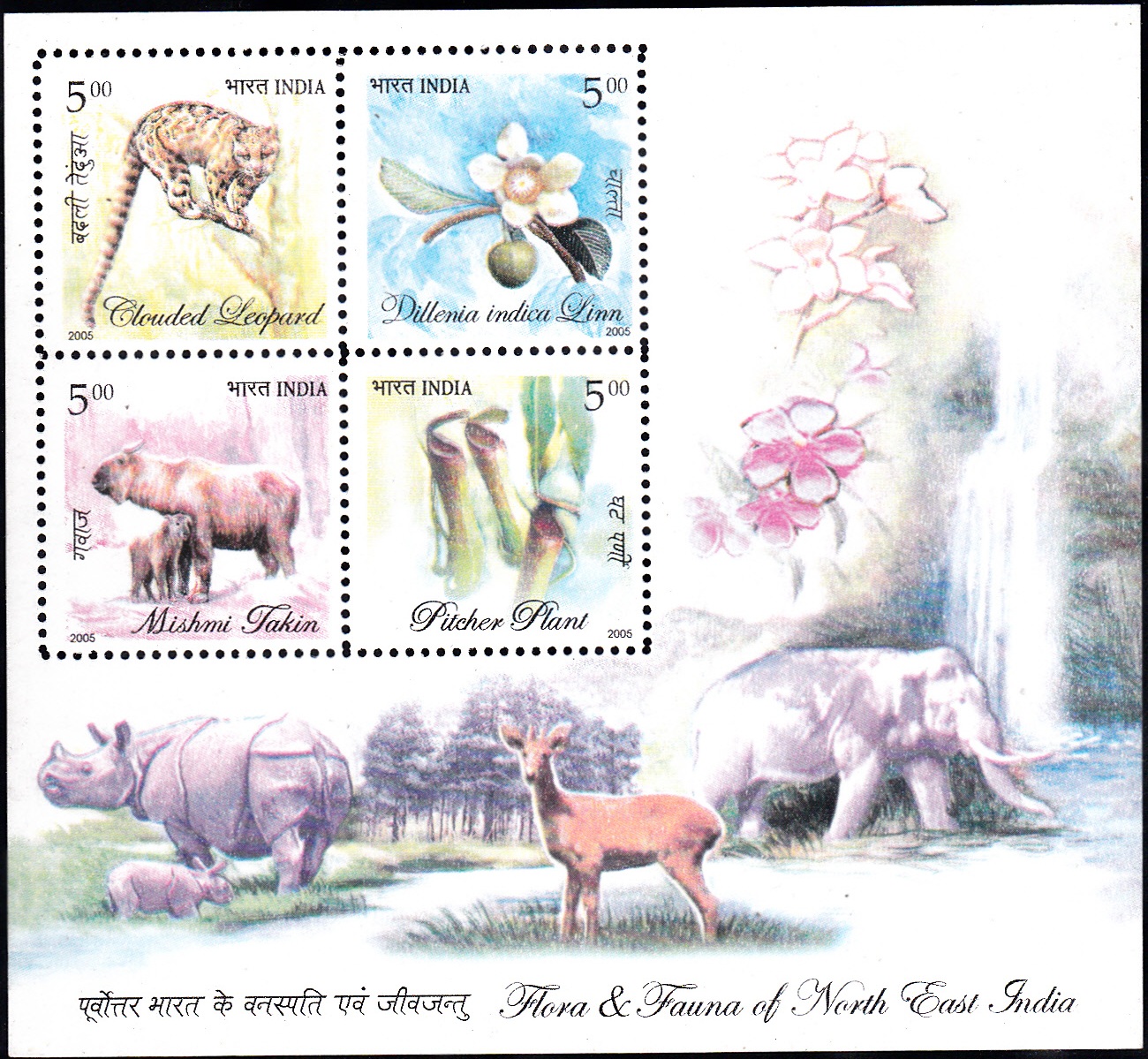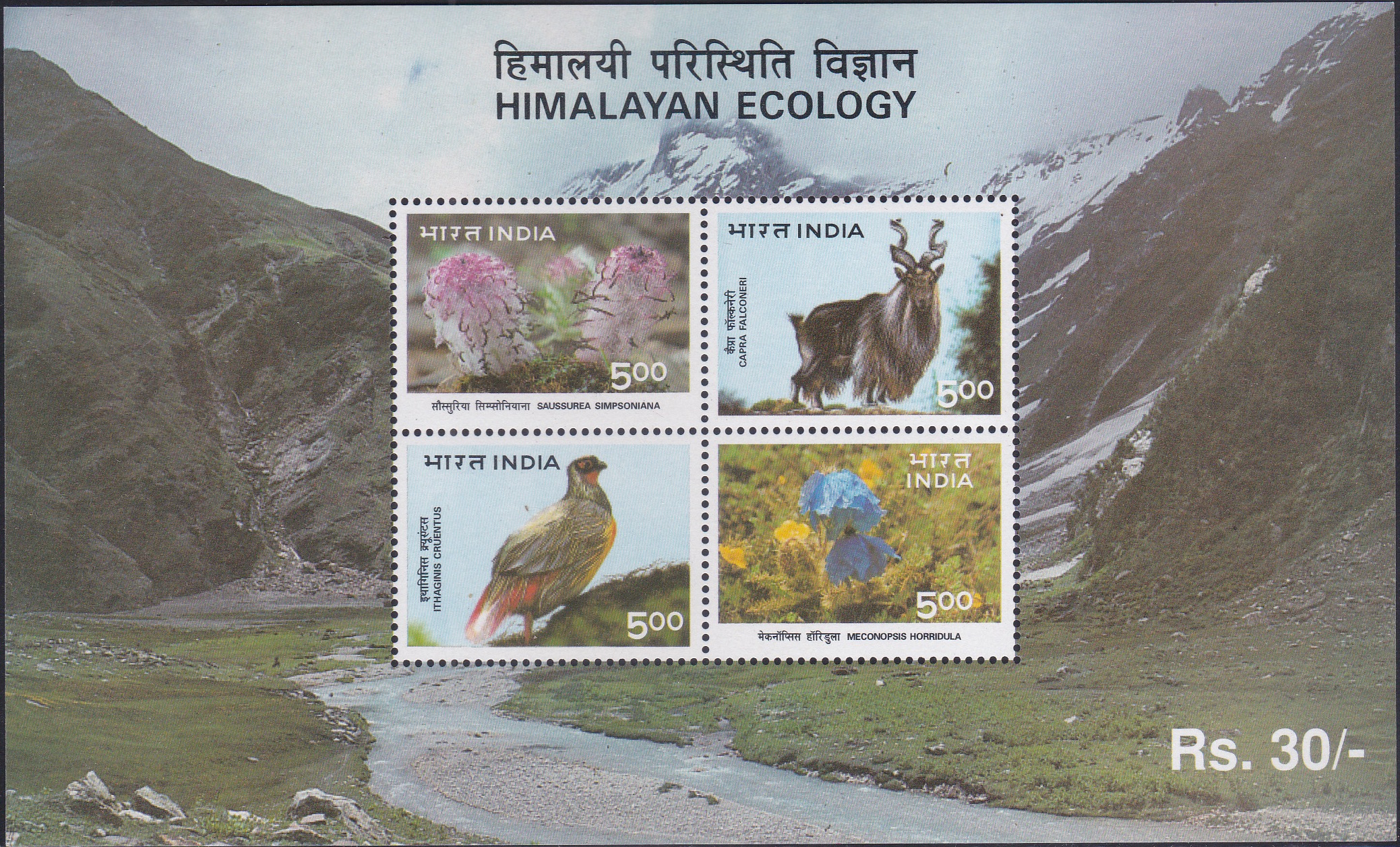
India on Himalayan Ecology 1996
A Miniature Sheet consisting of 4 nos of commemorative postage stamps on the Himalayan flora & fauna : Markhor, Blood Pheasant, Phen Kamal and Himalayan Poppy :

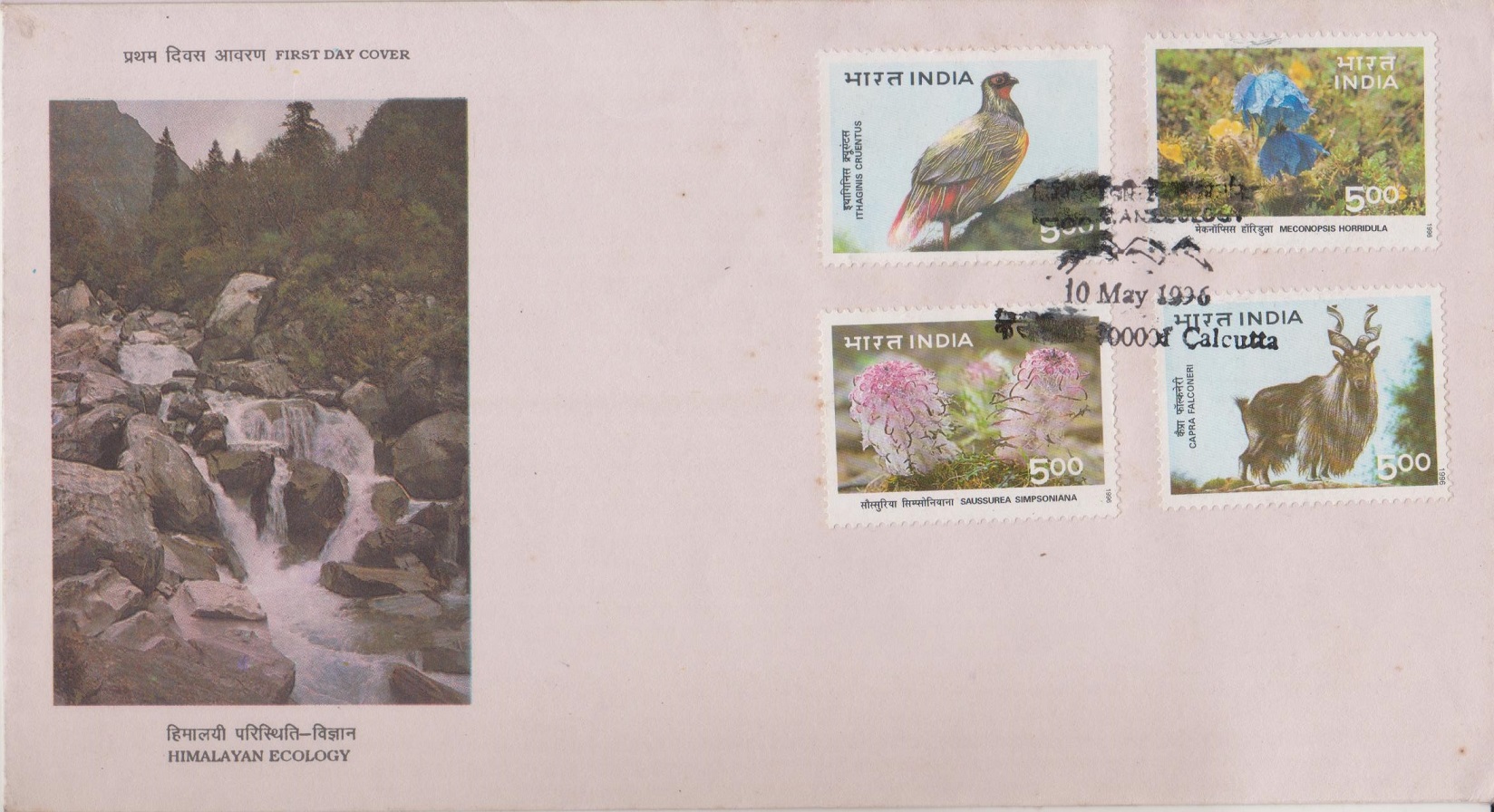 Issued by India
Issued by India
Issued on May 10, 1996
Issued for : India Post is proud to present a set of four special postage stamps on Himalayan Ecology. Each stamp highlights one rare specimen of Himalayan flora or fauna. We bring the beauty of the Himalayas to your notice in order to seek concerted effort to save it from destruction.
Design : The four stamps depict :
(i) Capra falconeri, the Markhor, found in the valley of Kashmir and westwards in the Hindukush. The old male, with its magnificent horns, a flowing beard and a generous mane from the neck and shoulders to the knees, appears almost patriarchal in its silent dignity. The winter coat of musty iron-grey turns short and red-brown in summer, growing grey with age. Females are dark fawn and about half the size of a well-grown male. Although the horns vary in different areas from the Indian to Afghan ranges, they are widely spaced with fine spirals. The Markhor therefore, while living where there are forests, keeps mainly to the open. They seldom go higher than the snow line. Their favourite haunt is precipitous crag and rock which secures them from attack.
(ii) Ithaginis Cruentus is the Blood Pheasant found in the Himalayas east of Nepal. Its bright red and black face is streaked gray above with a yellow crest and apple green below with yellow streaks. It is crimson on the upper breast, wings and tail. The female is a rich brown with scarlet around the eyes. The bird is gregarious, a strong runner, rarely flying. It feeds in open clearing and is almost tame sometimes, which leaves it vulnerable to attack. Its habitat is steep hill forest, bamboo, rhododendron and juniper scrub and it prefers snow-covered areas.
(iii) Saussurea Simpsoniana is a member of the sunflower family. Its peculiar shape with long woolly hairs look like a “yoga mudra” earning it local names like ‘Yogi Raj’ and ‘Yogi Padshah’ in Kashmir. In Uttarakhand it is commonly called “Phen Kamal”. This plant was photographed at an elevation of 4500 m on the slopes of Garhwal Himalayas in autumn.
(iv) Meconopsis Horridula is a Himalayan poppy owing its name to Greek ‘mekon’ (poppy) and ‘opsis’ (like). The plant is fiercely bristled (horridula) and bears deep azure blue flowers. Found in open stony areas at 4500 m – 5500 m in the Eastern Himalayas, this plant was photographed in late July in the Sikkim Himalayas where it is commonly called “Tsher Gnoin”.
The miniature sheet shows the Laspa Valley in the background.
The first day cover shows the Bhyundar Ganga which rises from Tipra glacier at the foot of Rataban and Ghouri Parbat peaks. It skirts the famous Valley of Flowers till its confluence with the Alaknanda at Govind Ghat, passing mixed temperate deciduous forests in its steep cascade.
Credits :
Stamps on flower & FDC & miniature sheet : Dr. Virendra Kumar
Stamps on fauna : Shri Ramesh Sukumar
Brochure : Centre for Inter Disciplinary Studies of Mountain & Hill Environment, University of Delhi and National Museum for Natural History, New Delhi.
Cancellation : Smt. Alka Sharma
Type : Miniature Sheet, Mint Condition
Colour : Multicolour
Denomination : 500 Paise each stamp & Rs. 30 Miniature Sheet
Overall size : 2.90 x 3.91 cms.
Printing size : 2.55 x 3.65 cms.
Perforation : 13.5 x 13.5
Paper : Matt Chromo
Number of Stamps Printed : One Million each
Number per issue sheet : 40
Printing Process : Photo Offset
Printer : Calcutta Security Printers Kanpur
About :
- Rising from the bottom of the seas, the Himalayan mountain range is one of the dominant features of the earth. Its vast stretches of ice-fields and rising spires of ice have played a key role in determining the climatic pattern of far away continents. Nearer home, it has been an equally dominant ecological feature; it harbours a flora and fauna alien to its latitudes and bridges biospheres of eastern and western hemispheres.
- It protected the Indian landmass from the icy winds of the north; brought in moisture laden winds rising from oceans in far away south and gave well defined seasons to the seasonless land of the tropics. Numerous rivers from the Himalayan watersheds transported loads of slit, eroded from rocky slopes depositing it along the helmline. Vast stretches of the great Indian plains with equally vast reservoirs of fresh water and life supporting minerals continually replenished by the ceaseless action of rivers bear testimony to this great effort.
- The Himalayan heights support diverse biomes, simulating climes of higher latitudes, arctic to temperate, lush green forests nourished by monsoons on the southern slopes and the cold deserts beyond the high pinnacles in the north.


